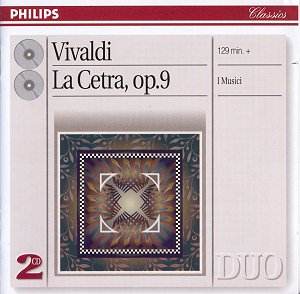Legend has it that Bach's Goldberg Variations were
written to soothe the insomnia of a count. If that count had been fortunate
enough to own this recording of Vivaldi's La Cetra, we would
have missed out on one of the greatest works in western music. I Musici
present here a plodding, boring recording that does not do justice to
Vivaldi's great music. Aside from the sound - dense, with too much reverberation,
and little separation among the instruments, which sometimes fade off
into the distance; aside from the scoring - two violins, cello and organ,
instead of a "proper" orchestra, even that of the size Vivaldi would
have used; aside from the approximate technique of lead violin Felix
Ayo, and his overuse of vibrato; this recording has no energy at all.
It sounds as though the musicians were on medication when recording
it.
Naturally, one must consider the context. Vivaldi's
music was not then (the 1960s) what it is today. It was played with
a romantic sound - and a violin style closer to Paganini - with obviously
a different idea of what this music was about. Even the virtuoso sections
of these works are merely played, not performed.
I Musici plod through this music as though merely passing
time. The slow movements are especially painful to listen to; I felt
like shouting out to the musicians to wake up and play the music, not
just the notes. This makes the twelve concertos pass as though they
were all different versions of the same work. There is hardly any change
in tempo among the respective movements of the different concerti -
all the first and third movements are played at the same tempo, all
the middle movements at tempo number 2.
As much as I would like to find something positive
to say about this recording, it is far too difficult. Take the opening
movement of the 3rd concerto in G minor: this shows many of the problems.
In the tutti sections, the instruments are all massed together sounding
like one; in the solo sections, the orchestra - violin, cello and organ
- are not enough to back up the soloist. The music sounds more like
a string quartet than a concerto. The middle movement of this same concerto,
which features a very slow, stepwise melody, is pedestrian and plodding.
The paucity of the "orchestra" makes the accompaniment too vague, and
the soloist merely plays his notes with little feeling, finding it difficult
to decide how much he should stand out over the other instruments. He
does change dynamics a bit, becoming more present, but there is no texture
in this music - here, with no organ, it sounds vapid and skeletal. Ayo's
ornamentation is all played by rote, with no inspiration as to what
ornaments mean, his vibrato is annoying, and, as he fades in and out
of the soundscape, I can only wonder if he wanted to be the soloist
in this movement. The closing movement of this concerto, which recalls
some of the tempestuous movements of the Four Seasons, lacks
vigour and energy, and, again, the lack of instruments turns it into
an exercise in futility.
This recording lacks pretty much everything that makes
Vivaldi such a great composer: energy, vigour, creativity, and good
sound. It comes out of another time when such pedestrian performances
could be praised, but today this stands more as an anachronism than
anything else.
Kirk McElhearn
